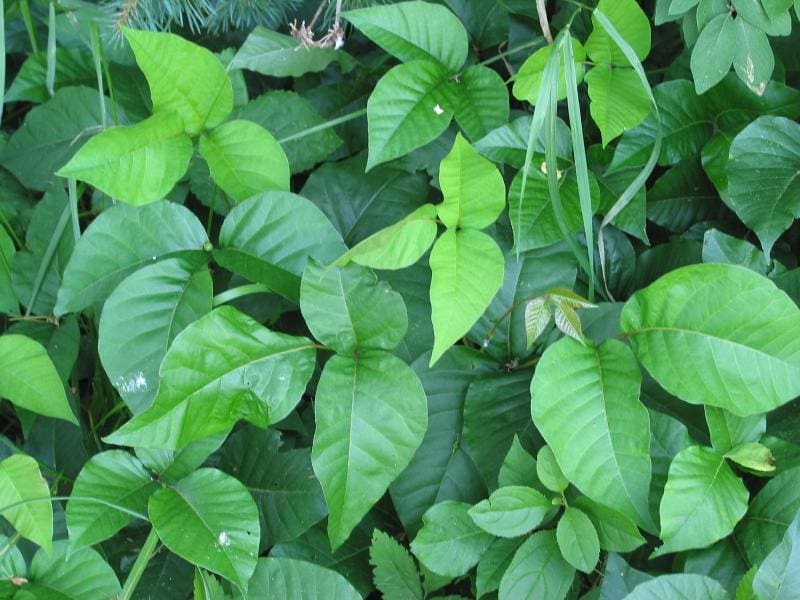
Rhus toxicodendron
Latin name: Rhus toxicodendron
Short name: Rhus-t
Common name: Poison Ivy | Poison Oak | Climbing Sumach | Rhus | Three-Leaf Ivy
Primary miasm: Sycotic Secondary miasm(s): Psoric, Syphilitic
Kingdom: Plants
Family: Anacardiaceae
- Symptomatology
- Remedy Information
- Differentiation & Application
Prepared from the fresh leaves of the Poison Ivy plant, Rhus toxicodendron, a woody vine or shrub native to North America. Contact with its oily resin, urushiol, causes intense allergic dermatitis.
Primarily known for its toxic properties, particularly contact dermatitis. Historically used in folk medicine for rheumatism, paralysis, and skin diseases in extremely small doses.
First proved by Hahnemann and extensively used and verified clinically by Boenninghausen, Hering, and others
- Fibrous tissues: ligaments, tendons, sheaths—rheumatism, sprains, overuse injuries
- Joints: stiffness, pain, aggravation from rest
- Skin: vesicular eruptions, intense itching
- Mucous membranes: inflammation of mouth, throat, genitals
- Nerves: motor weakness, restlessness
- Serous membranes: inflammatory effusions (pleuritis, pericarditis)
- Left side and lower extremities
- Febrile states with restlessness, aching, and amelioration from movement
- Continued motion: slow, gentle movement eases joint and muscular pains [Kent]
- Warm applications and hot baths
- Stretching, exercise after initial stiffness
- Dry weather
- Lying on hard surfaces
- Rubbing or massage
- Changing position frequently during rest or sleep
- First motion after rest (e.g. on waking or sitting for long periods)
- Rest, immobility, inactivity [Clarke]
- Cold, damp weather, especially cold rain
- Exposure to drafts or getting wet when perspiring
- Overexertion or sudden strain
- Nighttime, particularly after midnight
- Suppression of eruptions or perspiration
- Bryonia – Also has joint pain and restlessness, but Bry. is worse from movement and prefers to lie still; Rhus-t. is worse at first motion but better from continued movement.
- Arnica – Also for trauma and soreness, but Arn. is more bruised and shock-like, with aversion to touch and fear of being approached. Rhus-t. wants motion and stretching.
- Ruta – Similar in tendon and ligament affections, especially after overuse; Ruta is more focused on periosteal inflammation and eye strain.
- Dulcamara – Also worse from damp and cold, but more focused on mucous and glandular complaints; less restlessness.
- Sulphur – Shares skin symptoms, restlessness, and itch, but Sulphur is worse from warmth and washing; Rhus-t. is better from warmth.
- Complementary: Bry., Calc., Ars.
- Antidotes: Bell., Coff., Camph.
- Inimical: Apis
- Follows well: Arn., Ruta, Nux-v.
- Precedes well: Sulph., Calc., Lyc.
Rhus toxicodendron captures the dynamic of aggravation from rest and relief from motion. The patient must move to survive each joint stiffens, each fibre aches unless stirred. This is mirrored in the restless mind unable to settle, in need of change. It is the remedy of trauma, overuse, damp exposure, and internal agitation. Where there is pain, vesicles, heat, restlessness, and a need to keep going, Rhus-t. shines.
- Indispensable in sprains, strains, and sports injuries
- Go-to remedy for cold damp weather aggravations
- Excellent in restless fevers, flu, and typhoid
- Useful in herpes zoster, urticaria, and eczema with restlessness
- Ideal in post-operative stiffness
- Low potencies (6C–30C) for acute trauma or skin
- Higher potencies (200C–1M) for constitutional restless states
Mind
- Restlessness, internal and physical
- Fear, being poisoned
- Confusion, evening
- Anxiety, motion amel.
Head
- Headache, exertion after
- Scalp, itching
- Pain, occiput, motion amel.
Eyes
- Redness, burning
- Eyelids, oedema
- Conjunctivitis, damp weather after
Skin
- Itching, burning, eruptions
- Vesicles, yellow fluid
- Urticaria, from getting wet
- Erysipelas, face, left side
Joints / Extremities
- Pain, motion amel.
- Stiffness, first motion agg.
- Lameness, overexertion
- Trembling, limbs
- Pain, tearing, lower limbs
Sleep
- Restlessness, tosses about
- Waking, frequent
- Dreams, anxious
Fever
- Chill, after midnight
- Heat, with thirst
- Sweat, profuse, sour
Generalities
- Motion, amel.
- Rest, agg.
- Weather, cold damp, agg.
- Better, warm applications
Samuel Hahnemann – Materia Medica Pura: Original proving data, including aggravation from rest and skin eruptions
James Tyler Kent – Lectures on Homoeopathic Materia Medica: Emphasised mental and physical restlessness, trauma response
C. Hering – Guiding Symptoms of Our Materia Medica: Rich detail on vesicular eruptions, joint stiffness, and fevers
William Boericke – Pocket Manual of Homoeopathic Materia Medica: Provided clear modalities, rheumatic focus, and practical tips
John Henry Clarke – Dictionary of Practical Materia Medica: Contributed extensive detail on skin, eyes, and febrile conditions
